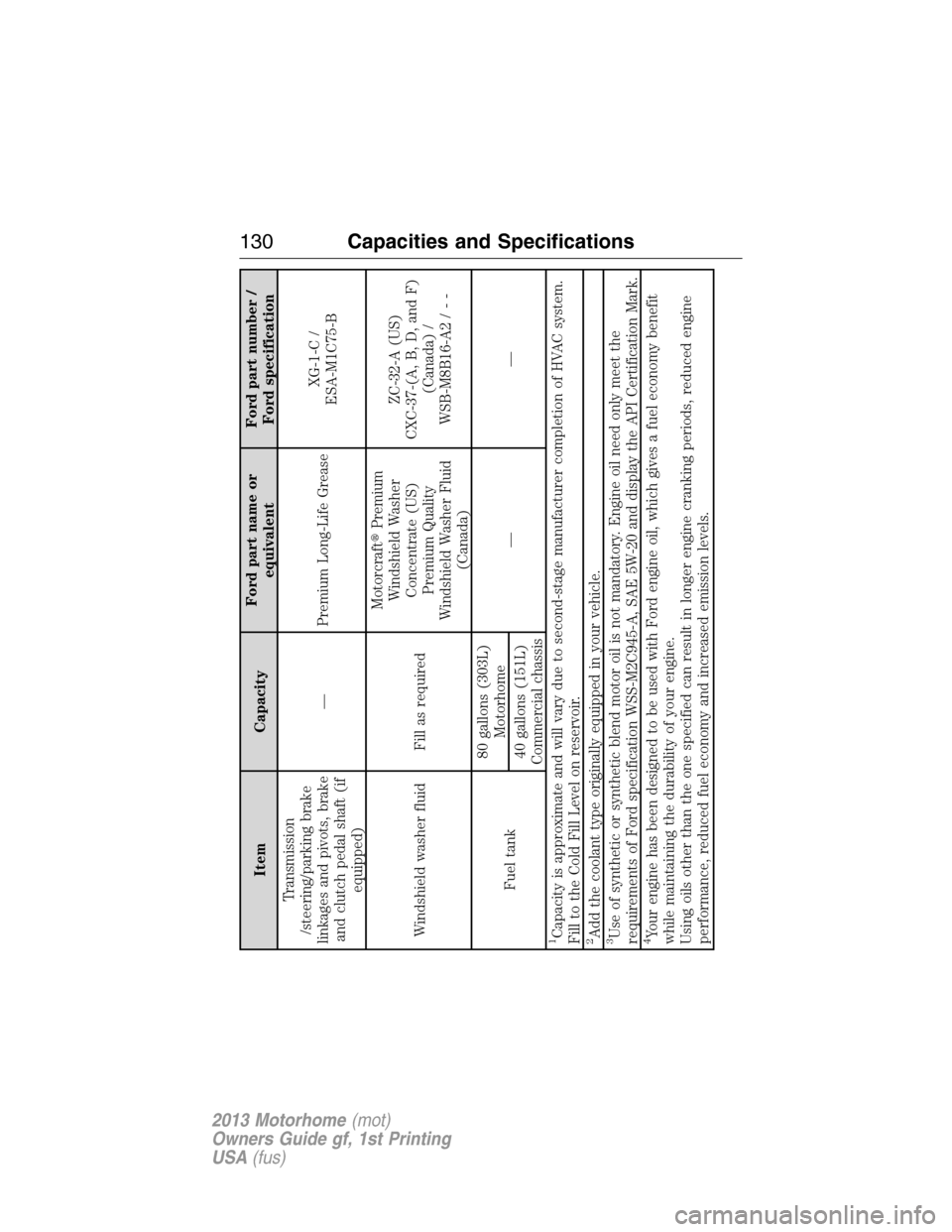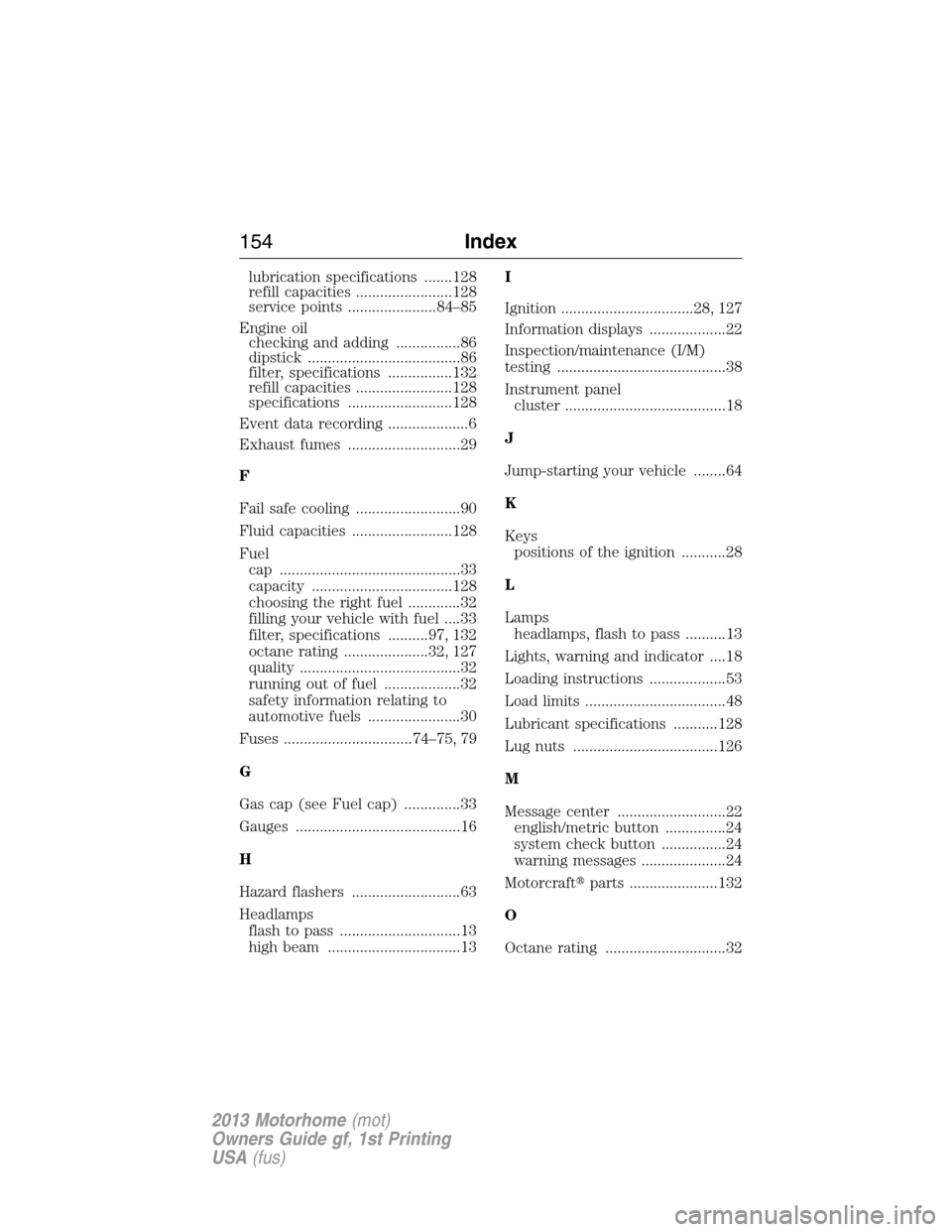Page 35 of 157

Your fuel tank filler cap has an indexed design with a 1/4th turn on and
off feature.When fueling your vehicle:
1. Turn the engine off.
2. Carefully turn the filler cap counterclockwise until it spins off.
3. Pull to remove the cap from the fuel filler pipe.
4. To install the cap, align the tabs on the cap with the notches on the
filler pipe.
5. Turn the filler cap clockwise 1/4 of a turn clockwise until it clicks at
least once.
If the check fuel cap light or a Check fuel cap message appears in the
information displays screen and stays on after you start the engine, the
fuel filler cap may not be properly installed.
If the fuel cap light remains on, at the next opportunity, safely pull off of
the road, remove the fuel filler cap, align the cap properly and reinstall
it. The check fuel cap light or Check fuel cap message may not reset
immediately; it may take several driving cycles for the indicators to turn
off. A driving cycle consists of an engine start-up (after four or more
hours with the engine off) followed by normal city and highway driving.
FUEL CONSUMPTION
Filling the tank
The advertised capacity is the indicated capacity and the empty reserve
combined. Indicated capacity is the difference in the amount of fuel in a
full tank and a tank when the fuel gauge indicates empty. Empty reserve
is the amount of fuel in the tank after the fuel gauge indicates empty.
Note:The amount of usable fuel in the empty reserve varies and should
not be relied upon to increase driving range. When refueling your vehicle
after the fuel gauge indicates empty, you might not be able to refuel the
full amount of the advertised capacity of the fuel tank due to the empty
reserve still present in the tank.
For consistent results when filling the fuel tank:
•Turn the ignition off before fueling; an inaccurate reading results if the
engine is left running.
•Use the same fill rate (low–medium–high) each time the tank is filled.
•Allow no more than two automatic click–offs when filling.
Results are most accurate when the filling method is consistent.
34Fuel and Refueling
2013 Motorhome(mot)
Owners Guide gf, 1st Printing
USA(fus)
Page 131 of 157

Item CapacityFord part name or
equivalentFord part number /
Ford specification
Transmission
/steering/parking brake
linkages and pivots, brake
and clutch pedal shaft (if
equipped)— Premium Long-Life GreaseXG-1-C /
ESA-M1C75-B
Windshield washer fluid Fill as requiredMotorcraft�Premium
Windshield Washer
Concentrate (US)
Premium Quality
Windshield Washer Fluid
(Canada)ZC-32-A (US)
CXC-37-(A, B, D, and F)
(Canada) /
WSB-M8B16-A2 / - -
Fuel tank80 gallons (303L)
Motorhome
——
40 gallons (151L)
Commercial chassis
1Capacity is approximate and will vary due to second-stage manufacturer completion of HVAC system.
Fill to the Cold Fill Level on reservoir.2Add the coolant type originally equipped in your vehicle.3Use of synthetic or synthetic blend motor oil is not mandatory. Engine oil need only meet the
requirements of Ford specification WSS-M2C945-A, SAE 5W-20 and display the API Certification Mark.4Your engine has been designed to be used with Ford engine oil, which gives a fuel economy benefit
while maintaining the durability of your engine.
Using oils other than the one specified can result in longer engine cranking periods, reduced engine
performance, reduced fuel economy and increased emission levels.
130Capacities and Specifications
2013 Motorhome(mot)
Owners Guide gf, 1st Printing
USA(fus)
Page 155 of 157

lubrication specifications .......128
refill capacities ........................128
service points ......................84–85
Engine oil
checking and adding ................86
dipstick ......................................86
filter, specifications ................132
refill capacities ........................128
specifications ..........................128
Event data recording ....................6
Exhaust fumes ............................29
F
Fail safe cooling ..........................90
Fluid capacities .........................128
Fuel
cap .............................................33
capacity ...................................128
choosing the right fuel .............32
filling your vehicle with fuel ....33
filter, specifications ..........97, 132
octane rating .....................32, 127
quality ........................................32
running out of fuel ...................32
safety information relating to
automotive fuels .......................30
Fuses ................................74–75, 79
G
Gas cap (see Fuel cap) ..............33
Gauges .........................................16
H
Hazard flashers ...........................63
Headlamps
flash to pass ..............................13
high beam .................................13I
Ignition .................................28, 127
Information displays ...................22
Inspection/maintenance (I/M)
testing ..........................................38
Instrument panel
cluster ........................................18
J
Jump-starting your vehicle ........64
K
Keys
positions of the ignition ...........28
L
Lamps
headlamps, flash to pass ..........13
Lights, warning and indicator ....18
Loading instructions ...................53
Load limits ...................................48
Lubricant specifications ...........128
Lug nuts ....................................126
M
Message center ...........................22
english/metric button ...............24
system check button ................24
warning messages .....................24
Motorcraft�parts ......................132
O
Octane rating ..............................32
154Index
2013 Motorhome(mot)
Owners Guide gf, 1st Printing
USA(fus)